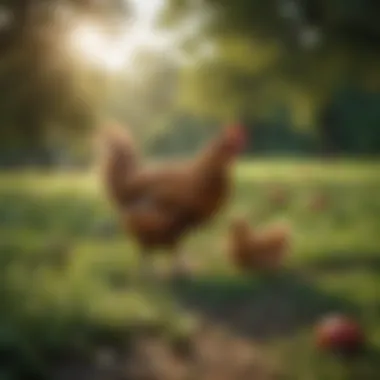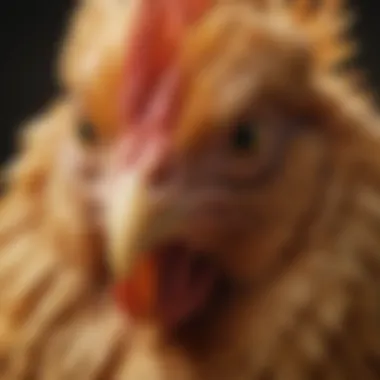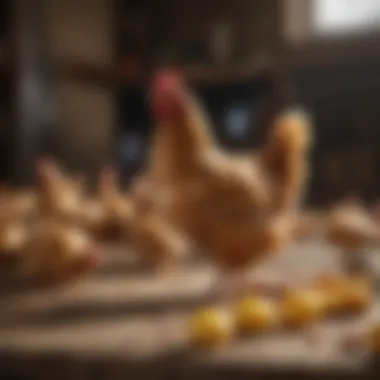Comprehensive Guide to Chicken Feed Requirements


Intro
Feeding chickens is a more complex subject than many might think. The nutrition requirements of chickens vary significantly based on their age, breed, and intended purpose, whether for eggs or meat. Understanding these requirements is essential for optimal growth and productivity. In this article, we will explore the various components that affect chicken feed needs, providing chicken owners with valuable insights and practical advice.
Farmers and backyard chicken keepers must recognize that the feed influences not only the productivity of their flock but also their overall health. This narrative will dissect the different feed types available, the essential nutritional needs across various stages of a chicken's life, and the best practices to ensure a balanced diet. Keeping these factors in mind helps to create a thriving environment for chickens, promoting well-being and longevity.
Nutritional Needs
The nutritional requirements of chickens change throughout their lives. Newly hatched chicks require a high-protein starter feed to support their rapid growth. As they transition into adolescence, their needs shift to a grower feed, which contains a proper balance of proteins and energy sources. Adult layers need a diet higher in calcium, as this mineral is vital for eggshell production.
- Chicks (0-6 weeks): Require starter feed, typically 20-24% protein.
- Grower Stage (6-20 weeks): Transition to grower feed, around 16-18% protein.
- Laying Hens (20 weeks and older): Shift to layer feed, containing about 16% protein and added calcium.
Understanding these developmental stages is key. It ensures that every chicken receives the necessary nutrients at the right time, thus enhancing growth and productivity.
Types of Chicken Feed
Various types of feed are available, each designed with specific needs in mind:
- Pellets: Often preferred for adult chickens, pellets are convenient and minimize waste.
- Crumbles: A good option for chicks and younger birds, as they are easier to eat.
- Mash: A less processed feed that allows for free-choice feeding but requires careful management to minimize spoilage.
In addition to commercial feeds, supplements such as grit, oyster shell, and vitamins may be beneficial. These enhance the diet, particularly in free-range systems where chickens may not receive adequate nutrition from their surroundings.
"Proper feeding is the cornerstone of a healthy chicken management system."
Feeding Practices
Developing an effective feeding regimen is crucial.
- Routine Feeding: Establish a consistent schedule to promote healthy eating habits. Chickens are creatures of habit and respond positively to routine.
- Free-Choice Feeding: Allowing chickens to eat at their will can be beneficial, especially in terms of maintaining weight. However, it needs proper monitoring to prevent overconsumption.
- Observation: Regularly assess the flock's condition by monitoring their weight, feather condition, and egg production.
These measures play an important role in maintaining a balanced diet tailored to specific nutritional needs, enhancing the health and productivity of your flock.
The End
Getting chicken feed requirements right is essential for any chicken owner. From understanding nutritional needs by age and breed to choosing the right feed type and implementing proper feeding practices, each decision made impacts the welfare of the chickens. By arming oneself with this knowledge, chicken owners can ensure that their flocks thrive, laying the foundation for a healthy and productive environment.
Intro to Chicken Feeding
Chicken feeding is a crucial aspect of poultry husbandry. The way chickens are fed directly impacts their growth, health, and productivity. For individuals interested in raising chickens, understanding the correct feeding practices is not just beneficial but essential. Well-nourished chickens tend to thrive, producing robust offspring and laying healthy eggs.
Several specific elements come into play when discussing chicken feeding. Firstly, the nutritional needs of chickens vary based on age, breed, and purpose. These factors collectively determine how much feed chickens require daily. For instance, chicks have different dietary needs compared to adult layers or broilers. Additionally, breed variations can cause differences in feed preferences and challenges.
Secondly, the benefits of understanding chicken feeding are multi-faceted. Nutritional deficiencies can result in poor health outcomes, affecting growth rates, egg production, and overall flock vitality. By ensuring that chickens receive a balanced diet, owners can minimize the risk of diseases tied to improper nutrition. Effective feeding practices lead to stronger chickens with better resistance to illnesses, ultimately resulting in more productive flocks.
One must also consider the different types of feed available on the market. Commercial feeds often come in pelleted or crumbled forms, each catering to a specific stage of growth. Furthermore, homemade feed options exist but require careful ingredient selection to ensure that all necessary nutrients are met. Understanding the impact of feed types will enhance the owner's ability to provide optimal nutrition for their flock.
Lastly, monitoring chicken health plays a significant role in appropriate feeding. Observing signs of good health and adjusting feed accordingly can prevent long-term issues. Owners need to stay informed about the signs of inadequate feeding, ensuring that chickens are consuming enough nutritious food.
In summary, a robust introduction to chicken feeding provides the foundation needed for successful poultry management. By encompassing the age, breed, and purpose of chickens, as well as recognizing the types of feed and monitoring health conditions, owners can make informed decisions. Such knowledge ultimately leads to healthier chickens and greater satisfaction in poultry care.
Factors Influencing Feed Requirements
Understanding the factors influencing chicken feed requirements is crucial for ensuring the health and productivity of poultry. Different aspects like age, breed, and the intended purpose of keeping chickens significantly affect their nutritional needs. Each of these factors adds complexity to feeding practices, necessitating tailored approaches to meet the specific dietary needs of the flock. This section will explore these determinants in detail and illuminate their importance to effective chicken management.
Age of the Chickens
Age plays a pivotal role in determining the right feed for chickens. Young chicks have different nutritional requirements compared to adult birds. In the initial days, chicks need starter feeds rich in protein to support their rapid growth. As they transition into the grower stage, the feed changes to accommodate a slower growth rate while still ensuring proper development. Lastly, adult chickens require feed specifically formulated for their role, whether it be for egg production or meat.
Breed Variations


Breead variations also dictate the nutrients required by chickens. Different breeds may have unique characteristics and growth rates, leading to differing feed requirements. For instance, some breeds are naturally heavier and may need higher caloric intake. Conversely, lighter breeds tend to thrive on less food. This is why knowing your flock's breed is essential in crafting a proper feeding plan.
Purpose of Keeping Chickens
The intention behind keeping chickens greatly influences what type of feed is necessary. There are three main categories:
Layers
Layers are chickens kept for their eggs. Their feed must promote optimal egg production, which typically requires a higher level of calcium and protein. The key characteristic of layers is their prolific egg-laying ability. Ensuring the right nutritional balance not only enhances egg quality but also maintains the health of the hens, making them a popular choice for poultry keepers.
Broilers
Broilers are raised primarily for meat. Their feed is designed to promote quick weight gain. The unique feature of broilers is their accelerated growth rate, which is markedly different from layers. While they can reach market weight in as little as six weeks, they also require careful management of their environment and diet to prevent health issues related to rapid growth. This makes them a beneficial but challenging option for many.
Dual-purpose breeds
Dual-purpose breeds serve both egg production and meat. They are versatile but may not excel in either category compared to specialized breeds. The key characteristic of dual-purpose breeds is their ability to adapt to various farming systems. They provide the benefit of flexibility, allowing smaller farms to sustain a flock for both meat and eggs without needing to manage separate breeds. However, their performance may be less predictable, which is a consideration for potential owners.
Understanding these factors helps ensure that chickens receive the appropriate nutrition they need to thrive, whether for layng eggs or for meat production.
Daily Feed Requirements by Age
Understanding the daily feed requirements by age is crucial for optimal chicken growth and health. As chickens age, their nutritional needs shift significantly. This knowledge helps owners provide the right نوع of feed that aligns with the chickens' developmental stages. By ensuring proper nutrition at each life stage, chicken keepers can enhance productivity, prevent health issues, and ultimately improve the quality of their flock's life.
Chick Feed Requirements
Beginner stage
The beginner stage of chickens lasts from hatch until about three weeks old. In this period, chicks are particularly vulnerable and require special attention to their feed. The feed must be high in protein and easily digestible to support their rapid growth.
One key characteristic of this stage is the high protein content, which is essential for developing their muscles and organs. A popular choice during this time is medicated starter feed, which helps protect against diseases. One unique feature of this feed is its fine texture, which encourages chicks to eat and minimizes waste.
However, challenges can arise if the chicks do not consume enough feed. Insufficient feeding can lead to stunted growth and health complications.
Transitioning to grower feeds
As chicks grow, around three weeks, they start transitioning to grower feeds. This change is important to continue healthy development as their energy needs increase. Grower feeds contain balanced nutrients to support skeletal and muscle development.
A fundamental aspect of this phase is adjusting the feed composition. Grower feeds tend to have lower protein levels compared to starter feeds but are rich in calcium and phosphorus to support bone development.
The transition can sometimes lead to feed refusal if not managed carefully. Gradually mixing starter feed with grower feed can help mitigate this issue and ensure a smooth adjustment in their diet.
Grower Feed Requirements
Feeding schedules
A structured feeding schedule becomes imperative as chickens reach the grower stage, typically from three weeks to about 16 weeks. Adhering to set feeding times not only establishes a routine but also contributes to better digestion and weight management.
One important characteristic of feeding schedules is their impact on growth consistency. Regular feeding encourages a balanced intake of nutrients, which is necessary for optimal weight gain.
This structure aids in preventing overfeeding or underfeeding. However, neglecting to adhere to a consistent schedule can lead to fluctuating weights or health issues.
Weight gain expectations
During the grower stage, monitoring weight gain is crucial. Owners can expect an average daily weight gain depending on the breed and feed quality.
A vital point is that the expectations can vary. For instance, broilers will have different weight gain targets compared to dual-purpose breeds. Owners often aim for a specific weight milestone to determine if their feeding practices are effective.
Knowing these expectations helps in adjusting feeding amounts and types as necessary. Inconsistency in weight gain can signal nutritional deficiencies or other health problems.
Layer Feed Requirements


Nutritional needs for egg production
Once chickens reach maturity, particularly hens, their diet changes once more to meet the demands of egg production. Layer feed, which is specifically formulated for this purpose, is crucial for maintaining health and optimizing egg quality.
A key characteristic of this feed is its elevated calcium content. Hens require additional calcium to develop strong eggshells. This specific need emphasizes the importance of transitioning to layer feed as they commence laying eggs.
Failing to provide adequate nutrients can result in production issues, including soft-shelled eggs or reduced egg yield. Therefore, understanding these nutritional needs is essential for any chicken keeper focusing on egg production.
Feed types for layers
Various types of feed are available for layers. Choices include pellet, crumble, and mash forms. Each type has its advantages based on ease of feeding and chicken preference.
A significant benefit of pelletized feed is its convenience and reduced waste. Hens often prefer pellets, which encourages consistent feeding. Conversely, mash allows for more nutrient variety but can lead to increased waste if not consumed promptly.
Choosing between these feed types can significantly impact egg production efficiency; thus, it is important to consider each option's benefits and how they relate to the flock's specific needs.
Type of Feed and Its Impact
The type of feed chosen for chickens plays a crucial role in their overall health and productivity. Different feeds cater to various nutritional needs and can affect growth rates, egg production, and disease resistance. Understanding these feed types enables owners to make educated choices that align with their specific goals, whether for meat production or egg-laying. It is essential to recognize that not all feeds are created equally, and selecting the right one involves a few nuanced considerations.
Commercial Feed
Commercial feed forms the backbone of many chicken farms. This feed is usually formulated to meet the nutrient requirements of chickens at different life stages.
Pelleted vs. crumbled
Pelleted feeds have a compact form that provides a uniform nutrient profile. This type is often easier for chickens to consume, minimizing waste. Crumbled feeds, on the other hand, are smaller and can encourage more natural foraging behaviors. Each has its contributions and drawbacks:
- Pelleted feeds are beneficial because they reduce selective eating. Chickens ingest nutrients evenly, leading to consistent growth. However, some chickens may find them less appealing at first.
- Crumble feeds allow chickens to eat at their preferred pace. This form may encourage play and exploration but can lead to increased waste as chickens pick through the feed.
Considering the feeding habits of your chickens can guide this choice.
Nutritional value considerations
Selecting feed should always involve a careful assessment of its nutritional value. Quality commercial feeds are often formulated with the right balance of proteins, fats, vitamins, and minerals.
- Essential nutrients in commercial feed directly impact chicken health. Poor quality feed with inadequate nutrients could lead to stunted growth or low egg production.
- It is important to check the labels of feed types. When formulating diets for layers or broilers, ensuring complete nutrition helps maintain optimal health. Lower-quality feeds often depend on fillers that provide less energy or nutrients to chickens.
Homemade Feed Options
Homemade feed can be an alternative that some owners prefer. This allows for control over the ingredients used, leading to potentially fresher options.
Ingredient selection
Choosing the right ingredients is vital for homemade chicken feed. Nutritional balance starts with a foundation of high-quality grains, proteins, and supplements.
- Flexibility in ingredient selection gives owners the power to tailor mixes according to specific needs or preferences of their flock.
- However, it requires knowledge of necessary nutrients. Inaccurate formulations can lead to deficiencies and impact chicken health negatively.
Balancing nutrients
Balancing nutrients in homemade feeds is crucial. Each ingredient contributes unique benefits, and understanding these can help avoid imbalances.
- Protein sources, like soy or peas, support growth and egg production. Also, carbohydrates from grains provide energy.
- Careful measuring and mixing are required to ensure that all nutritional needs are met. A poorly balanced diet can result in problems, such as reduced productivity or health complications.
Proper feed choice and management correlate with chicken well-being and productivity.
Monitoring Chicken Health and Feed Consumption
Monitoring the health of your chickens and their feed consumption is a fundamental practice for any poultry owner. It ensures that the birds receive adequate nutrition and maintain optimum health. Observing your flock provides insight into their overall well-being and can pinpoint issues before they escalate. The following sections detail key indicators of inadequate feeding and how to adjust your feeding regimen based on observations.
Signs of Inadequate Feeding


Weight loss indicators
Weight loss in chickens is one of the most noticeable signs of inadequate feeding. Chickens that are not receiving enough nutrients will lose weight, which is critical when it comes to their growth and egg production. Monitoring weight should be part of routine health checks. A sudden drop in weight can indicate an issue with the feed quality or quantity.
A well-maintained chicken should have a rounded breast and a firm feel. If you can feel the bones sharply or if the breast muscle seems flattened, these are clear weight loss indicators. This aspect helps in understanding the nutritional shortfalls in their diet. Proper feeding ensures healthy growth rates and optimal egg production.
The advantage of paid close intenttion to weight loss is that it is easily observable by any chicken owner. However, one downside is that weight loss may not always be immediate or visible without prior experience.
Behavioral changes
Behavioral changes in chickens can also signal inadequate nutrition. Healthy chickens are active, curious, and social. When chickens are not receiving enough food, they may show signs of lethargy or isolation from the flock. For instance, decreased foraging or a reluctance to engage in typical social interactions might indicate something is amiss in their diet.
The key characteristic of observing behavioral changes is that it allows for proactive management of the flock’s well-being. Noticing such changes early can guide adjustments in the feed type or amount. However, one unique challenge of relying solely on behavior is that it may be influenced by various environmental factors, which can complicate interpretation.
Adjusting Feed Based on Observation
Adjusting feed based on your observations is vital for maintaining the health of your chickens. When signs of inadequate feeding are detected, it is essential to make immediate adjustments. This might include changing the feed type or modifying the feeding schedule. In some situations, it might also be necessary to increase the portion sizes provided.
Keeping track of any changes observed in feeding behavior, weight, or general health will inform further adjustments and create a more responsive feeding strategy.
Furthermore, documenting these observations helps in understanding the overall trends in the flock's health. Whether it is seasonal changes or shifts in feed availability, adapting to these factors is crucial for the well-being of your chickens. Regular monitoring leads to informed decisions, ultimately enhancing the health and productivity of your birds.
Seasonal Feeding Adjustments
Adjusting chicken feed requirements according to the seasons is crucial for optimizing the health and productivity of the flock. The changing weather impacts the chickens' nutritional needs and behavior. Therefore, being aware of and implementing seasonal feeding adjustments is vital for all chicken keepers. In this section, we will discuss the necessary adjustments to feeding practices in winter and summer.
Winter Feed Considerations
Caloric needs increase
In winter, chickens face lower temperatures which directly impact their caloric needs. As the outside temperature drops, chickens expend more energy to maintain their body temperature. This results in an increase in the amount of feed they require on a daily basis. Providing adequate calories not only supports their energy levels but also promotes general health.
Increasing the calorie intake often involves selecting feed with higher fat content. This can mean including grains like corn, which are energy-dense. These adjustments can help ensure that chickens are kept warm and are not at risk of health issues associated with cold stress. Not meeting these caloric needs can result in reduced egg production or even weight loss in the birds.
Effect of cold on feed consumption
The cold weather can lead to reduced feed consumption as chickens may not eat as much when they feel uncomfortable. This decreased intake can be a concern, as it may result in insufficient nutrition. To counteract this, some owners have found that offering a warm mash, or moist feed can encourage eating during cold months. The warmth and moisture may make the feed more appealing, tempting chickens to eat enough to satisfy their nutritional needs.
Additionally, it is key to monitor the actual feed intake. Observing feeding behavior allows adjustments to be made if chickens are not consuming feed adequately. Not addressing these factors can lead to health problems and lower productivity.
Summer Feed Adjustments
Hydration and heat management
Summer brings its own challenges, including heat stress. Chicken hydration is particularly important during this time. As temperatures rise, chickens may drink more water to cool their bodies down. Ensuring that clean water is available at all times is non-negotiable.
Heat management involves offering feed that helps them cope with warmer temperatures. This might mean choosing lighter, easily digestible feeds. Ingredients such as oats or peas can be good options. Proper hydration and food management also help maintain good egg quality, as heat stress can adversely affect both chicken health and egg production.
Minimizing heat stress in feed choice
Selecting the right type of feed is essential for minimizing heat stress impact on chickens. Feeds that produce less metabolic heat during digestion are preferable. Generally, feeds that are lower in protein might help reduce metabolic heat, which is a benefit during hot weather.
Feeding practices should also be modified, such as offering smaller, more frequent meals rather than a large meal in the heat of the day. This strategy may aid in better consumption without overwhelming the birds during the hottest parts of the day. Not managing heat stress properly can have consequences not just on productivity but also on the health and welfare of the chickens.
In summary, both winter and summer offer unique challenges that require thoughtful adjustments in feeding practices. These seasonal adjustments form an integral part of chicken management that ensures the well-being of the flock.
Epilogue
Key aspects to consider include:
- Age and Breed: Different chicken ages and breeds have varied nutritional needs. For instance, chicks require protein-rich feeds to grow, while layers need diets high in calcium for egg production.
- Purpose of Keeping Chickens: Whether for egg production, meat or as pets, the feeding requirements change. Understanding these variations can help in selecting the right feed types.
"Feeding the right nutrition builds a strong foundation for the flock’s overall well-being."
- Seasonal Adjustments: Different seasons bring unique challenges. In winter, chickens need more calories to maintain body heat, whereas in summer, hydration becomes critical. Owners must adjust diets accordingly to reflect these changes.
- Monitoring Health: Keeping a close eye on feed consumption and the overall condition of chickens can prevent health issues. Changes in weight or behavior often indicate that adjustments in diet are necessary.
By synthesizing these aspects, chicken owners can make well-informed feeding choices, thus enhancing their flock’s welfare and productivity. In summary, a thorough understanding of chicken feed requirements is essential for anyone involved in poultry care. It not only supports the chickens' immediate health but also contributes to the long-term success of maintaining a thriving flock.







